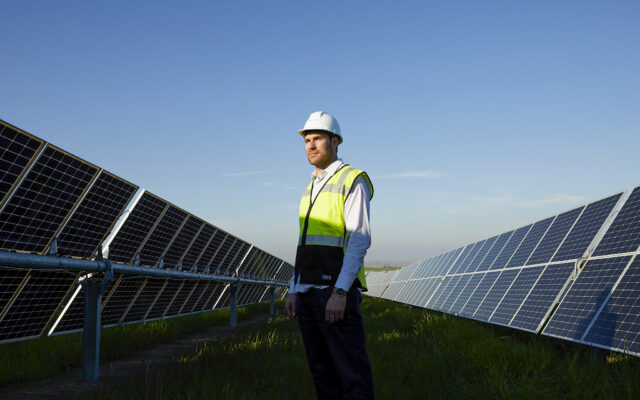|
Getting your Trinity Audio player ready...
|
According to the International Energy Agency (IEA), which compiles and analyzes data from the global energy sector, solar energy is advancing faster than envisioned just a year ago. The agency revised its previous projections in late 2022 on what is to come from solar energy. In a nutshell, they say solar will surpass coal and natural gas in total power capacity by 2027 and become the largest energy source in the world.
All matters of technology, politics, and sustainability aside, the reason for this is simple: “Solar has the best economics of any energy source, and the Lazard data among many other sources have proven this,” says Alex Roedel, vice president of design and engineering for Nextracker, the leading manufacturer of solar tracking systems already at work on six continents. “We now have a situation where the economics of solar and scalable technologies combined create the lowest energy cost without subsidies. This is why utility-scale solar energy is undergoing exponential growth.”

Nextracker plays a big role in those emerging technologies, but it makes neither solar panels nor batteries. The company provides intelligent and integrated solar tracking systems and software solutions for ground-mounted, utility-scale solar projects. Their key products, NX Horizon, NX Horizon-XTR, and NX Gemini —which are all run by the company’s proprietary optimization and monitoring software packages—intelligently respond to the movement of the sun and factor for uneven terrain, shadows, overcast weather, and extreme weather events.
Further, the company designs and builds with minimal soil disruption, which otherwise adds to construction costs and its carbon footprint. Bulldozing land to accommodate a standard, straight line solar array can also harm native species and lead to soil erosion from altered watersheds. A Nextracker-supported solar field will undulate with the land and still maximize its energy production. This also has the added benefit of reducing steel in the supporting structures (an alternative way to build on uneven terrain is to simply build taller support structures, which adds to costs).
“We now have a situation where the economics of solar and scalable technologies combined create the lowest energy cost without subsidies. This is why utility-scale solar energy is undergoing exponential growth.”
Alex Roedel
Roedel speaks passionately about how smart installations of solar farms makes them more productive. Nextracker has been part of the construction of solar farms since the company was founded in 2013, most of them with panels that track the sun—morning to evening, adjusting also to the earth’s seasonal tilt—so panels are perpendicular to the sunlight. This achieves maximum electric production from the entire solar project.
An IPO by the company in February 2023 exceeded expectations; yet another endorsement that smart money is on solar power.
Currently, Texas is the largest producer of new solar-generated electricity in the US. But with Nextracker products in place, significantly larger solar farms are now operating in places north of the Sun Belt. One solar farm is the Mammoth Solar project in northwest Indiana that extends over 13,000 acres, which is the approximate surface area of 1,000 football fields. In addition, there is the Double Black Diamond Solar Project that powers 85,000 homes in Illinois.
Those are largely on flat lands, the ideal topography for a solar farm. But much of the world is hilly and even mountainous, which formerly made utility-scale solar power less profitable to construct.
“We’ve figured out ways to adapt to rolling hills,” Roedel says. “And that brings down the cost of solar in places like the southeast portion of the US, which is hilly.” They accomplish this with the NX Horizon-XTR, a product that simplifies construction on undulating tracts of land. An added benefit of not bulldozing the land is that it can expedite the permitting process.
These more cost efficient, adaptive technologies also offer important benefits in developing countries where electricity, and therefore internet connectivity, are not yet available. In countries such as Mali, Angola, and Kazakhstan, the rural areas can leapfrog fossil-fuel generated power and go straight to solar-generated electricity.
“By using differentiated single-axis tracker design and intelligent control capabilities to mitigate these risks, stakeholders can meet financial expectations and unlock new and varied solar development opportunities.”
Alex Roedel
Among the white papers Roedel has written is a two-part series, “Mitigating Extreme Weather Risk,” advising how the company can mitigate hail, snow, floods, sand, and soil accumulations that damage solar panels or diminish productivity. In a nutshell, the company is able to assess region-specific risk profiles in the project design stage and use the products and software to reduce damage and insurance claims.
“By using differentiated single-axis tracker design and intelligent control capabilities to mitigate these risks, stakeholders can meet financial expectations and unlock new and varied solar development opportunities,” Roedel writes.
These days, Roedel is now responsible for a team of 60 engineers who design Nextracker systems around the world. How does he manage that? “I don’t hire myself,” he says. “I look for different kinds of people. Diversity is big for us. We need different engineering solutions for every site and the kinds of innovative people who can solve problems in smart ways. The best ideas come from a diverse team that represents the world we live in.”
SOLV Energy is a solar EPC and services provider for utility solar, high-voltage substation and energy storage markets across North America. We believe that good energy has a ripple effect. That’s why we only take on projects that provide cleaner power, better jobs, greater education and a brighter future for our communities. SOLV Energy has worked closely with the Nextracker team to deploy and optimize innovative tracking solutions on 7GW of solar energy projects.


